air distribution
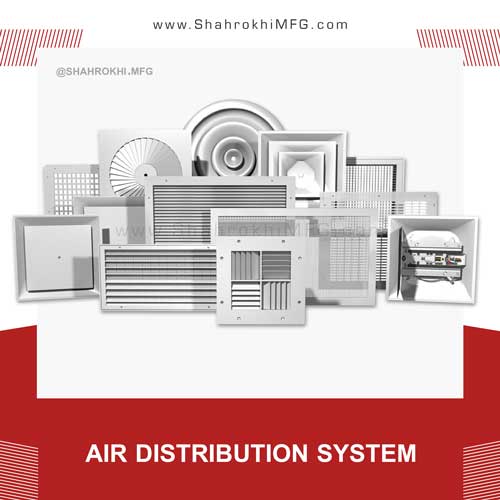
Air distribution – Shahrokhi air distribution system
Introduction
The conditions of the human environment have a direct effect on his mental states, physical condition, the way of doing work and in general all aspects of his life. Since the majority of human life today is spent inside the building, it is important to create favorable environmental conditions in the building, whether it is a workplace or a home, etc., the most important part of which is providing comfortable air for the residents of the building according to their type of activity.
In fact, the purpose of planning, calculating and installing the HVAC system is to create pleasant air for the residents according to their type of activity in the building, and the correct distribution of air in the rooms is the last step to achieve this goal, which plays a decisive role in creating comfortable conditions for the residents. Will have.
Air distribution
The transfer of a certain air flow, generally through the channel to the space or from the space(s) used, is called air distribution. Along the duct may be placed devices for the purpose of changing the conditions of the air (for example, purification, heating, cooling, humidification or dehumidification, etc.), which are called air conditioning devices, which are not discussed here.
Air distribution in the room may be done through ceiling diffusers or wall registers. Before introducing the types of air distribution registers, the principles of air distribution are discussed briefly.
Air distribution in the operation space is carried out by air distribution devices, which are called air terminals, in such a way that predetermined conditions, such as the amount of air volume change, pressure, filtration, temperature, humidity, air speed, and sound level in an area to fulfill a certain requirement in this space, which is called the performance area. Air terminals are the common boundary between the operation space and the air distribution system.
Air distribution has principles, among which the following can be mentioned:
- Room temperature: The air distribution in the room should be proportional so that the temperature changes in different parts of the room do not exceed a certain limit.
- Primary and secondary air: The primary air is the amount of air that enters the room directly through the register, and the secondary air is the volume of air in the room that is displaced by the primary air and participates in the air circulation with it.
- Air flow speed in the room: The best air movement speed for the occupants of the room is 50 feet per minute, especially when they are sitting. For buildings such as stores and factories where people are moving slowly, this speed can be increased to 150 feet per minute. Speeds higher than the permissible limit cause discomfort when the air hits the face or body of the residents.
- Air throw length: It is the horizontal distance that the air flow travels with respect to the air inlet register in the room. This distance is measured from the location of the air inlet to the point where the speed of the air flow reaches a certain minimum. This speed is at least 50 feet per minute.
- Direction of air flow: This issue is also involved in creating comfortable conditions for residents.
- The speed of the air exiting the register: this speed should be determined according to the sound limit in the room. Suggested speeds for air exit from the register are listed in Table 1. It is necessary to explain that these speeds are determined based on the useful surface of the register, and the useful surface of the register is the product of the dimensions of the register minus the surfaces of the register blades.
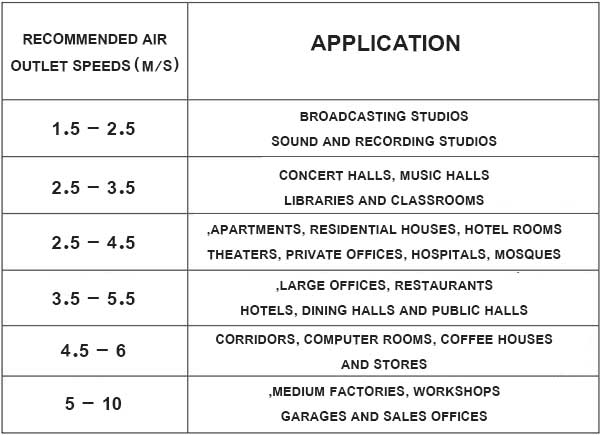
Recommended air outlet speeds
The following are the main components of the air distribution system, and if necessary, these definitions are chosen according to the direction of the air flow inside the channel:
- Air flow equalizers:
These components are used in order to make the speed uniform in the cross section of the flow, or to reduce the relative amount of flow disturbances, or to reduce the amount of possible rotation of the air flow.
Current balancers include:
Directional blades that are used in certain parts of the channel to reduce flow disturbances.
- Straightening components in the form of squares or honeycombs, which are used in order to eliminate the possible rotation of the air flow.
- Mesh plates, nets or similar components are used to even out the velocity distribution by increasing the pressure drop.
Dampers:
These devices can be used inside the air channels or together with the air terminals, in which case they are able to correct the air resistance of the system and thus change the passing air flow rate or control the air flow and in addition, if necessary, cut off the air flow.
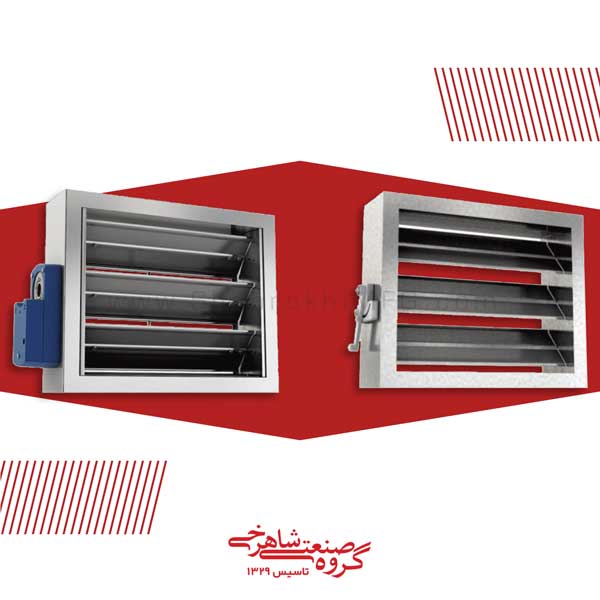
Two examples of manual and motorized channel dampers
Types of air distribution registers
In order to better distribute the air in the room or space to be ventilated, a distribution register is used.
The types of air distribution registers are:
1- Wall registers:
2- Ceiling Diffusers:
- Square and round ceiling Diffusers
- Round and square operating chamber register
- Conical square ceiling Diffusers
- Spherical ceiling Diffusers
Next, two examples of these registers (double-sided wall register and square ceiling diffusers) will be described.
Two-way wall register
The two-way wall register with two rows of adjustable vanes has a number of horizontal and vertical parallel vanes that can be moved at any angle around its central axis. These registers are usually used for exhaust air. Horizontal and vertical blades can move at any angle.
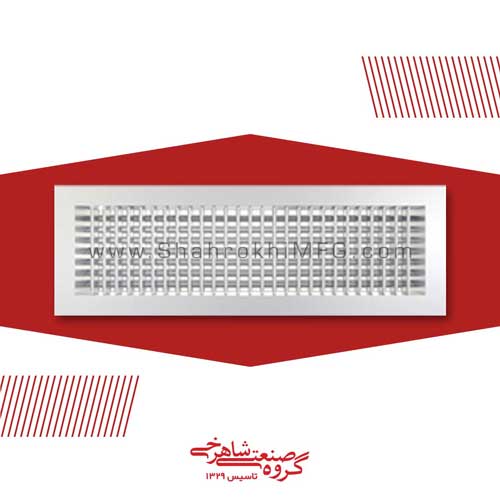
Two-way wall register
The air regulation vanes, which are placed together parallel to the suitable cross-section for air passage, make it possible for the air flow to pass uniformly, with calmness and low pressure drop.
It is possible for the vanes to be fixed at an angle selectively during the manufacturing process, which is called the fixed type, and it is also possible that these vanes can be manually adjusted to any angle, which is called the movable type.
Plastic bushings or linear springs are used to separate the spokes from the frame in order to eliminate noise, and thus, the spokes are under tension during adjustment.
Several types of frames are available upon request, and the choice of frame type depends on the installation location of the registers.
Blades and frame are made of 1.25 mm thick aluminum profile with an anodized aluminum coating of good quality.
It is possible to use iron instead of aluminum upon request, and it is also possible to do the final painting by spraying liquid or powder paint (electrostatic).
Square ceiling diffusers
Square ceiling diffusers are designed to be installed in the ceiling for suitable applications in the air conditioning industry. These registers are used for air flow, return and discharge, which spread uniform air flow horizontally by successive concentric vanes. These blades have the ability to distribute air in one to four directions.
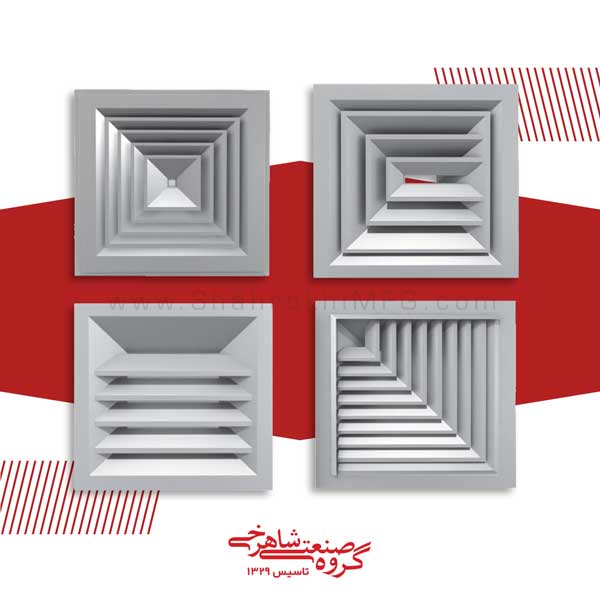
One-way, two-way, three-way and four-way ceiling diffusers
These types of registers are easily installed on the square channel or by a conversion on the round channel. In these types of registers, the high amount of air distribution in the space under the roof makes the temperature and velocity of the mixed air quickly balance.
There are several types of frames for this type of register, the choice of which depends on the installation location of the registers. In some of these frames, it is possible for the internal blades to come out of the frame to install the register, adjust the damper, and wash. It is also possible to adjust the damper by creating a hole in the inner blades.
Frames and spokes are made of 1.25 mm thick aluminum profile with an anodized aluminum coating of good quality. It is possible that the final coloring can be done by spraying liquid or powder paint (electrostatic).

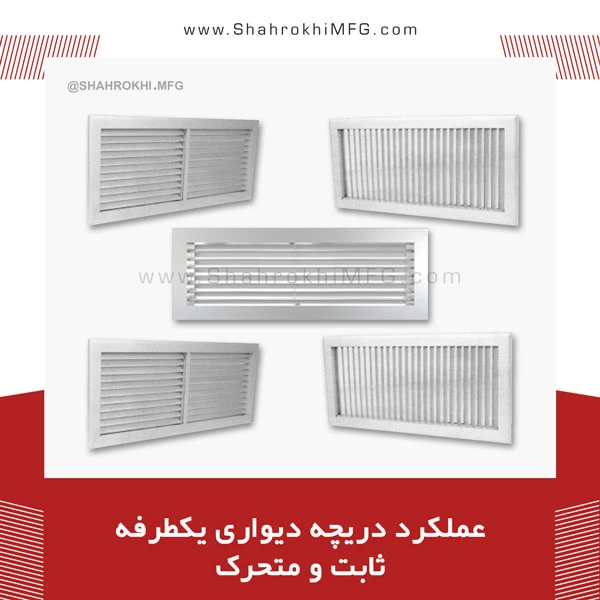
Leave a Reply
Want to join the discussion?Feel free to contribute!